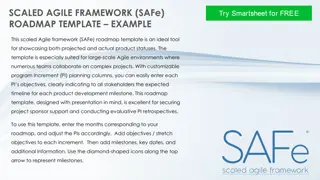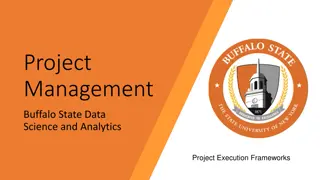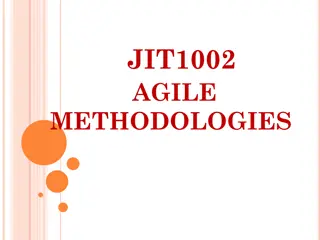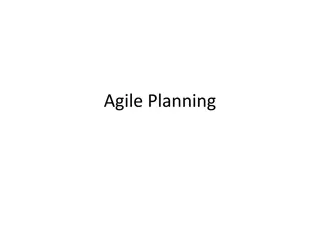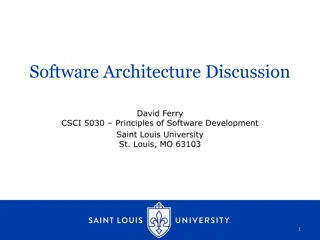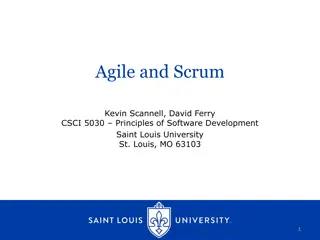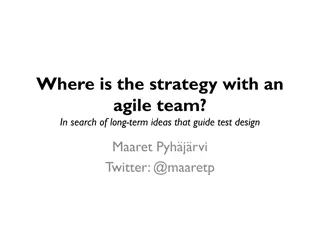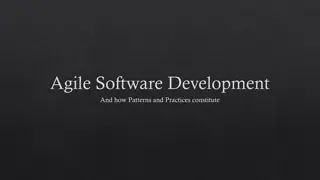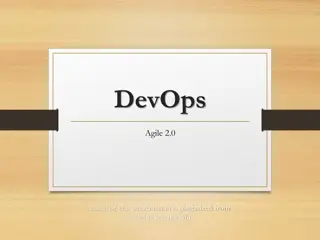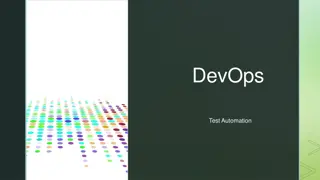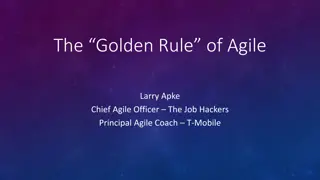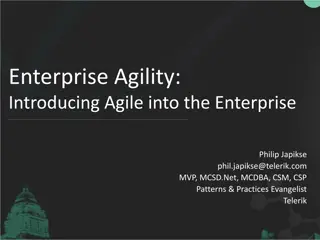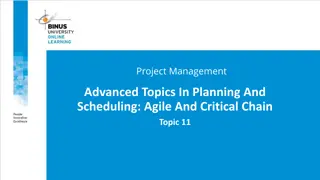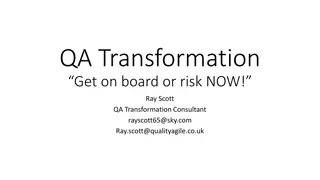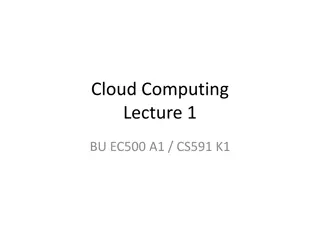Understanding Continuous Integration and Agile Methodologies
Continuous Integration involves frequent integration of team members' work to detect errors quickly, leading to cohesive software development. Agile methodologies emphasize adaptive planning, collaboration, and responsiveness to change, minimizing the risk of irrelevance in a changing world. The Agile Manifesto guides iterative, people-centric software development with values like individuals over processes, working software over documentation, customer collaboration, and responsiveness to change.
Download Presentation

Please find below an Image/Link to download the presentation.
The content on the website is provided AS IS for your information and personal use only. It may not be sold, licensed, or shared on other websites without obtaining consent from the author. Download presentation by click this link. If you encounter any issues during the download, it is possible that the publisher has removed the file from their server.
E N D
Presentation Transcript
Continuous Integration CONTINUOUS INTEGRATION IN AGILE ENVIRONMENT
What is continuous integration ? Continuous Integration is a software development practice where members of a team integrate their work frequently, usually each person integrates at least daily - leading to multiple integrations integration is verified by an automated build (including test) to detect integration errors as quickly as possible. Many teams find that this approach leads to significantly reduced integration problems and allows a team to develop cohesive software more rapidly. Martin Fowler per day. Each
So what exactly is Agile and why has it become so popular so quickly? LET S EXPLORE EXACTLY WHAT AGILE METHODOLOGIES ENTAIL. SPECIFICALLY, WE'LL COVER: HOW DOES TESTING FIT INTO AGILE METHODOLOGIES? WHAT ARE THE DIFFERENT WAYS TO TEST ON AN AGILE TEAM?
These methodologies are rooted in adaptive planning, early delivery and continuous improvement, all with an eye toward being able to respond to change quickly and easily. In simple words Ability to adapt to change
Agile principles are all about being collaborative, flexible and adaptive. It s built on the premise that the world now changes regularly, and that means software teams no longer have years to bring new products to market. In that time, competitor offerings or customer expectations can change, and the team risks irrelevance. Agile minimizes this risk by helping teams collaborate together more by adapting to what the team needs to be successful.
Agile Manifesto Agile software development focuses on keeping code simple, testing often and delivering functional bits of the application as soon as they're ready. The Agile Manifesto was created as an alternative to document-driven, heavyweight software development processes such as the waterfall approach. The Agile Manifesto, also called the Manifesto for Agile Software Development, is a formal proclamation of four key values and 12 principles to guide an iterative and people- centric approach to software development
The four core values of agile software development as stated by the Agile Manifesto emphasize: 1. Individuals and interactions over processes and tools. 2. Working software over comprehensive documentation. 3. Customer collaboration over contract negotiation. Responding to change over following a plan.
The 12 principles laid down in the Agile Manifesto 1. Satisfying 'customers' through early and continuous delivery of valuable work. 2. Breaking big work down into smaller components that can be completed quickly. 3. Recognizing that the best work emerges from self-organizing teams. 4. Providing motivated individuals with the environment and support they need and trust them to get the job done. 5. Creating processes that promote sustainable efforts. 6. Maintaining a constant pace for completed work. 7. Welcoming changing requirements, even late in a project. 8. Assembling the project team and business owners on a daily basis throughout the project. 9. At regular intervals, having the team reflect upon how to become more effective, then tuning and adjusting behavior accordingly. 10. Measuring progress by the amount of completed work. 11. Continually seeking excellence. 12. Harnessing change for competitive advantage.
Testing challenges in the AGILE environment 1. Prioritizing requirements based on risk since it s not possible to test everything 2. Automating tests to increase efficiency 3. Increasing the use of exploratory testing to accelerate the time from code delivery to test completion and to emphasize the need to create code that works 4. Adapting to changes from sprint to sprint 5. Sprint gets over planned 6. 1000 dependencies in the project 7. You will never get that finish line
Agile Methodologies Scrum Kanban Testing Methods Development (BDD) Behavior Driven (Cucumber test framework) Development (ATDD) Acceptance Test Driven Some key words to know Product Owner Scrum Master Developers Engineers Automation Testers Sprint
Unit tests are narrow in scope and typically verify the behaviour of individual methods or functions. Integration tests make sure that multiple components behave correctly together. This can involve several classes as well as testing the integration with other services. Acceptance tests are similar to the integration tests but they focus on the business cases rather than the components themselves. UI tests will make sure that the application functions correctly from a user perspective.
How Continuous Integration looks today? Multiple specific configurations of tools to develop, build, deploy, and manage an application.
Pipeline: Automate builds, unit tests, deployments, and more. The stages in the pipeline can automatically build when you push changes to a linked repository and then deploy to one or more environments on the Cloud. You can also incorporate builds and deployments into your toolchains to connect builds to other tools.
Build Alliance with Developers Choose Test Framework for productivity Flaky test == 0 test Flaky tests could be harmful for developers because their failures do not always indicate bugs in the code
Source version control tools CVS SVN GIT GitHubis a code hosting platform for version control and collaboration. It lets you and others work together on projects from anywhere. GitHub essentials: Repositories, Branches, Commits, and Pull Requests. Tutorial: https://guides.github.com/activities/hello- world/
Open Source Continuous Integration Servers The leading open source automation server, Jenkins provides hundreds of plugins to support building, deploying and automating any project. Why Jenkins? GUI (Graphical user interface) Strong community and eco system Free! Can setup with real devices Full control!! https://www.tutorialspoint.com/jenkins/index.htm
What's the Difference Between Continuous Integration and Continuous Delivery CI/CD Continuous Integration (CI): short-lived feature branches, team is merging to master branch multiple times per day, fully automated build and test process which gives feedback within 10 minutes; deployment is manual. Continuous Delivery (CD): CI + the entire software release process is automated, it may be composed of multiple stages, and deployment to production is manual.
Continuous integration, continuous deployment, and continuous delivery - vectors that have the same direction Continuous delivery extends CI/CD so that all changes that pass the CI/CD phase are immediately exposed to customers. With continuous delivery customers get faster access to new features and bug fixes, and developers get more immediate feedback about the changes they ve made.
Continuous Deployment tools CircleCI scontinuous integration and delivery plaCircleCI s continuous integration and delivery platform helps software teams rapidly release code with confidence by automating the build, test, and deploy process. Puppet Pipelines for Applications Automate application deployments with full control Automate application deployments with approvals, gates and triggers to deliver the correct versions of your software to production, with one-click rollbacks and audit trails for every action taken.
Continuous Deployment tools Distribution channel for mobile application TestFairy provides enterprise companies with a mobile testing platform for distributing apps, collecting insights, submitting feedbacks and crashes from testers, and streamlining mobile development. HockeyApp is a service that allows developers to recruit and manage testers, distribute apps, and collect crash reports, among other things. TestFlight app allows testers to install and beta test apps on iOS, tvOS and watchOS devices.


